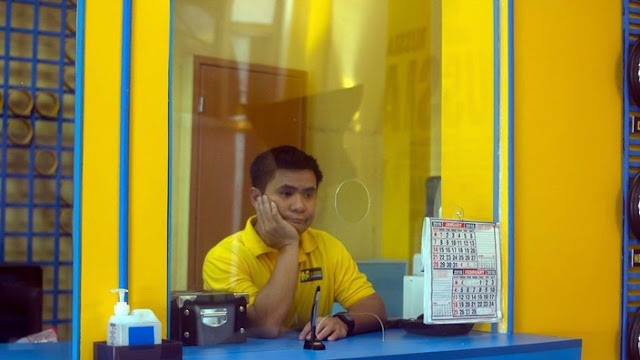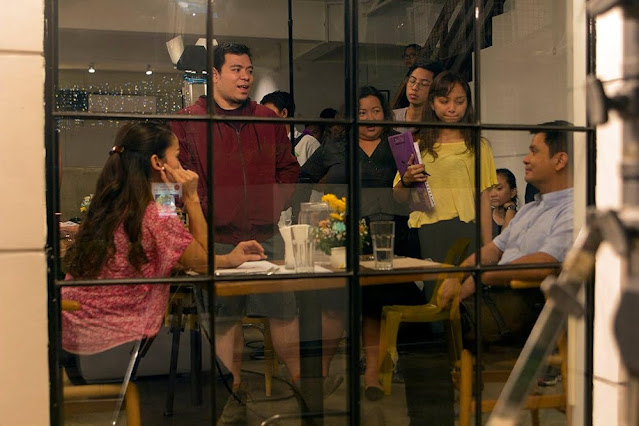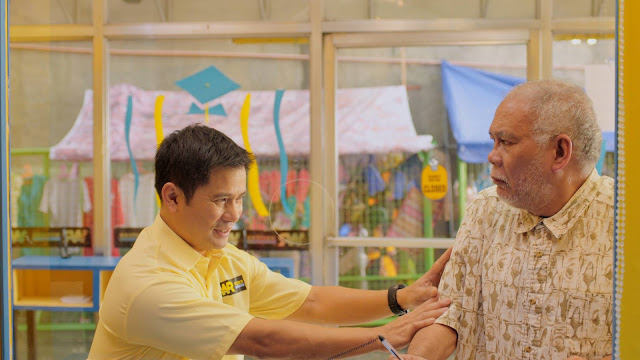Do not be fooled by his spacey way of talking, young director James Robin Mayo knows what he wants and dares to dream. After all, he got Filipino entertainment icon and veteran Ogie Alcasid to headline his Cinemalaya production Kuya Wes. In fact, Ogie did not only agree to play the lead in James’ film, he also jumped in as a producer and even roped in matinee idol Piolo Pascual and his company Spring Films to produce Kuya Wes. Despite his youth, James has managed to sync all these heavyweights together into a watertight and harmonious little film.
Awash with yellow, reminiscent of Western Union the brand, Kuya Wes the film tells the story of an earnest remittance centre staff named Kuya Wes who falls in love with one of his regular walk-in customers. Played by Ogie Alcasid (pictured above), Kuya Wes has a permanent aura of sunshine, not unlike the yellow production set. Together with the use of caricatures and snappy editing, one gets reminded of mobile phone TV commercials and the rather cutesy world the characters live in. Played by Ina Raymundo, known for some of her siren roles in the 90s, the character Erika is a much needed counterbalance to the mild insanity of Kuya Wes and even his manager, played by comedienne Moi Bien. Erika is grounded and real, almost like she belonged to another film. But of course, this serves an important purpose at the end of the film - to prevent a happily ever after cliche that would have marred the film.
Of course, James knows better than to succumb to a rom-com trapping. The film delights with very clever editing and and comfortable pacing. Despite his youth, Kuya Wes reflects the craft of a relatively confident director. After all, James is quite a rising star in the indie circles. His full-length debut feature The Chanters won Best Screenplay and Best Actress at QCinema International Film Festival 2017, and also had multiple nominations at the Gawad Urian Awards 2018. James braved the monsoon rains to arrive at the CCP for this interview with SINdie.
Jeremy (J): I really like how the film ended.
James Robin (R): From my vision, the remittance centre is like an aquarium and Kuya Wes is a fish looking outside. And at the end, when he goes out of the aquarium, suddenly it's our turn to become the fish.
J: That’s a really good analogy.
R: In my first frame, he was standing inside the centre looking out. If you look closely, his eyes are looking at us.
J: I really like the editing. It is very snappy and clever.
R: During pre-production, we actually wrote the screenplay according to this edit we had in mind.
J: You have a very interesting motley bunch of characters. Why these characters?
R: The characters are based on the people around us. If you look closely, the characters all have problems. They appear somewhat happy but deep inside they are lonely. They are masking their loneliness with other things, such as photos. For instance, the girl who shares her photos. She needs attention from her family which is living abroad. So she is telling these stories to others as a way of reminding herself of her family. And the guy with the beard, he has so many girls but no one he loves. The old man, he just like to be outside and not stay at home.
J: When did this whole project start?
R: The project started as a script in 2016. 2016 was the deadline for Cinemalaya 2018. So, I had this concept and I met Denise O'Hara. And she told me she had a similar concept and it was almost done. So we decided to go ahead with this concept and develop it.
J: Is Denise like everybody’s writer? I see her name everywhere.
R: Haha no. Denise is our friend. We have this circle of friends and we just help each other. In fact, Denise has three works in this festival - Mamang, Kuya Wes and Mr Wiggles. In fact, the director of Mr Wiggles, Jav Velasco is a friend too.
J: I read about how the scale of the project changed drastically when Ogie came on board. How did you meet Ogie in the first place?
R: I asked Ferdinand Lapuz, one of our producers to pass the script to Ogie.
J: Was Ogie your first choice?
R: Yes he was our first choice. (pause) In the Philippines, there are many comedians but for Ogie, he can be a comedian and a serious actor at the same time with his looks. You can take him seriously. Most of his films are slapstick comedy. I think he has not done anything serious and he has the potential for that.


J: So you have never met Ogie at all before the production?
R: No. So, it was either within the same day or the day after that he said he liked the script and wanted to do it. So we were surprised, because in our experience, it was difficult to get what we wanted on our first try. It’s always the second choice.
J: Did it cross your mind how you were going to fit him into the budget and all that?
R: Yes. But him coming on board also became one of our biggest advantages, because Ogie is one of the biggest stars in the Philippines. And it made it an easy sell to the producers. So we talked several producers and Ogie talked to Piolo Pascual. Piolo is one of the matinee idols here in the Philippines. He liked the script and of course the rest was history.
J: How did it feel to be working with all these big characters from show business, being a relatively young director?
R: At first, I was scared and nervous. But our actors are very nice and not intimidating. They are very approachable and collaborative. The trust that they gave to me allowed me to easily execute my vision.
J: How do they see independent filmmakers like yourself? I mean they are from mainstream cinema right?
R: I think right now, given that Cinemalaya is very established, many of these mainstream actors are interested in doing it because they can try something different. They can have roles that are not mainstream. They like it.
R: Now, I think she is doing some soap operas and TV series. Her most notable role was in the 90s in the film Tuhog. It has a Gawad Urian nomination, and Gawad Urian is one of the most prestigious award-giving bodies in the Philippines. She was very good in it.
J: And Moi Bien.
R: Moi Bien is comedienne and this is her third film and her second main support role. Last year, she had an entry in which she played a maid. This time, she played a character that is not a subordinate character. She is in fact the protagonist’s superior.
J: You know Spring Films which is one of your producers also produced Kita Kita, a highly successful indie rom-com in the Philippines. What do you think made it so successful?
R: In my opinion, it was the matching of Alessandra de Rossi and Empoy Marquez. It is not the typical rom-com in which you see a matinee idol partnering with a beautiful girl. Here, we see a character that is not that ‘matinee-idol-like’. I think the casting in the film kind of reflects a bit of reality, that you don't always need to have matinee idol looks to have the girl. Sometimes the funny ones can get the girl. I think girls seem to like funny guys more than handsome guys!
J: Why the story of a remittance centre? Is it because it is representative of the Philippines?
R: Initially, Denise knew someone from a remittance company. There was an employee like Kuya Wes. He knows every customer. So I thought why not do a story about a character that knows everybody but is lonely deep inside. One of the concepts we wanted to explore was the idea that love can be measured and counted. So the remittance centre fulfilled this concept and if you notice, a lot of numbers appear in the film.
J: So that’s a motif you wanted to explore.
R: Yes. Exactly.
J: Any funny incidents during production to share?
R: We shot the film in June and in June in the Philippines, there are always storms because of the typhoons. This June we had three typhoons and one time during production, our lights flew away and we had to stop shooting.
J: It flew away? Did you have to pay for it?
R: No no no. But the grips had to run for it, and were just shouting and laughing. (pause) You know we always say this to the people we know, that we have a happy set. I don’t like people with bad vibes. Even if there are problems, everyone should be optimistic.
J: Any reason for the choice of yellow in the film?
R: I think yellow is a bright colour and a happy colour. And we like to depict the remittance centre as one of his sanctuaries so it is supposed to be a happy place.
J: Actually, it looks like Western Union!
J: What kind of stories interest you as a filmmaker?
R: I am still exploring. For now, I am thinking of doing a horror film next or a fantasy film.
J: Do you like horror?
R: I think I am scared. But that also means I know what is scary.
J: When you watch a horror movie, do you watch it with one eye closed?
R: Sometimes. One recent horror film I like is The Wailing. It’s a Korean film.
J: Do you have a mantra in filmmaking?
R: I think just stick to your vision and be open to criticism, because film is collaborative. Sometimes, you can get blindsided by your love for the material that you fail to see the other things, the small details that can affect the bigger picture. So I think you should always be open to others. It’s team effort. You have to be a leader and team player and not a boss.
Interview and photos by Jeremy Sing



